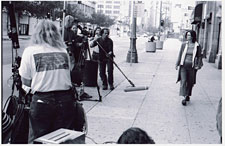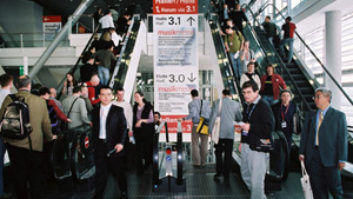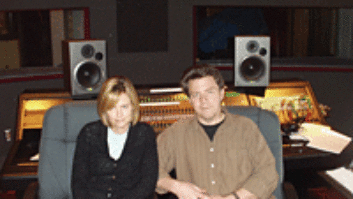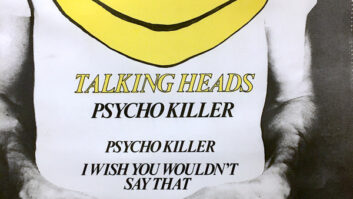
When George Lucas famously postulated that sound was 50 percent of the movie-going experience, a generation of audio professionals began to see themselves as more than just technicians. As they pulled apart production sound and put it back together, designers and editors employed ambience, ADR, plug-ins, recorded effects and Foley to underscore story points and further the filmmaking process.
Production mixer Lori Dovi worked on the Foley footsteps for indie film November.
photo: Courtesy Sony Pictures Classics
Sadly, someone forgot to tell the budget people about the “half-the-movie” deal. Sound may be widely acknowledged as an essential filmmaking component, but most film executives have trouble understanding why there should be six or more sound editors when picture departments only have one. Only on big-budget features — which account for a mere eight percent of the film market — will production companies hire a minimum of one editor each for Foley, ADR, dialog, backgrounds, hard effects and design.
On projects where budgets do not allow for that level of staffing, clear communication with the director and composer, a production mixer willing to go the extra mile and the supervising sound editor’s experience can be the difference between leaden soundtracks that indie films often end up with and pure gold. With schedules pared down to four or five weeks, short or nonexistent predubs, ProControl final mixes and a maximum of two or three editors, somehow, some way, these supervisors bring clarity, craft and nuance to the work of our best indie directors.
LESSONS FROM BIG-BUDGET FEATURES
Glenn Morgan of Soundelux has become something of a specialist in the low-budget arena. His recent credits, among more than 100, include Monster’s Ball, Reefer Madness (Mix, April 2005), Open Water and — don’t laugh — Jackass. These films may be “financially challenged,” as he wryly puts it, but their success is a function of the filmmakers’ ability to make the best use of minimal resources and the extent to which they allow sound to play a crucial role. “The key is being able to identify the important moments of a film,” Morgan says. “You have to know the project, and listen and communicate with the filmmakers really well.”
On big features, of course, everything gets covered. “The director will give you the palette to make it the greatest-sounding thing possible,” he says. “You’re talking about budgets that are over $1 million. You have the time and the resources.”
But on lower-budget projects, where distribution is uncertain and there isn’t much mix time in the schedule, choosing what to cover — decisions often made by the sound supervisor — can mean the difference between a festival sale and a quick disappearance. One of the biggest mistakes an inexperienced supervisor will make is to try and cover everything and then run out of time. “Having the experience from those $1 million-plus-budget movies allows me to look at a film and pick the things that are important,” says Morgan.
Another supervising sound editor who brings big-budget experience to small-budget features is Skywalker Sound’s Frank Eulner. “We all know what we can do and what could be done if there was time,” he says. “With these low-budget jobs, it’s the ‘Art of What Not to Do.’”
With 50-odd feature credits under his belt, working with directors such as M. Night Shyamalan (The Village) and Phillip Kaufman (Quills, Twisted), Eulner has witnessed and taken part in the decision-making process on numerous occasions. It takes confidence to decide on focusing on one area, leaving another mostly untouched. “A very important thing is having a director who understands what you’re going to contribute to the film and how you’re going to do it when you spot the film,” Eulner says.
COMMUNICATING WITH THE COMPOSER
The director’s spotting session is also a good time to find out how much music is coming and where it’s going to be placed. “If music’s carrying the ball, I’m staying out of it,” says Eulner. “I’ll do very little and move onto a scene where music is not being used and fill it out with effects and Foley.”
Morgan adds, “I always ask to come to the composer’s spotting session so I have an idea what they’re thinking and what they’re going to attempt, so there isn’t this massive crash on the dub stage.” That classic moment where composer and sound designer butt heads about whose brilliant work gets to pay off in the big fight scene is a less-likely occurrence on small features, where these decisions are made early on. For this reason, communication and collaboration between designer and composer can be superior on small-budget features.
Composer Marco D’Ambrosio has been a well-kept secret on features such as Swimming With Sharks, Haiku Tunnel, Vampire Hunter D and the Japanese anime series Jojo. But that may change with his recent invitation to the 2005 Sundance Composer’s labs. D’Ambrosio always requests sound design tracks far in advance of the mix to anticipate complex blending decisions and facilitate a collaboration that is rare in the big-budget game. “I’ll get a bounce and load that into my workstation when I’m writing,” he says. “If I’ve got cues that are starting to be fleshed out and approved, I give the editors temp passes so they can cut in and work their sounds against that.”
Working with veteran sound designer Tom Myers (Jersey Girl, Revenge of the Sith and numerous Pixar projects), D’Ambrosio even went so far as to alter his compositions to accommodate sound design. “We’d always talk about, you know, ‘Tom’s going to do something tonal here so I’ll just be heavy on the percussion,’” D’Ambrosio says. “And then it might be the other way around, where Tom’s just kind of hitting effects really hard but something needs to carry the track from the beginning of the scene, and that’s where I’ll have more of a sustain or a melodic thing going. You sort of pick the domain of where you’re going to be hanging out in the audio spectrum.”
D’Ambrosio’s experience points to the particular intimacy created on independent projects. “If you and the sound designer are on the same team, so to speak, then there are less issues involved,” he says. “You’re not duplicating efforts, and there’s less tension and confusion. You want to make best use of your time before the mix stage, which is typically where the dollars are flying the fastest.”
EVERY PART OF THE ANIMAL
Saving time and money can end up being a big part of the supervisor’s job; another way to keep those dollars grounded is by hiring editors who can wear a number of hats. “My sound designer is also my effects editor and my backgrounds editor,” says Morgan. “My dialog editor will also cut the adr. The Foley tends to fall by default to whoever has the available time. There are some very talented people in their own individual disciplines. The challenge is to find a crew that is able to do cross-platform.”
Multitasking editors is especially important when considering the relationship between effects and dialog: Dialog editors save time for the effects department by using every part of the animal, so to speak, including effects that were recorded in production. “My dialog editor will communicate with the effects editor and let them know what is working and what isn’t so that we don’t have to double-cut things,” Morgan says.
This labor-saving device can sometimes yield elements that work better than what an effects department might have recorded had there been time. In Monster’s Ball, one of the biggest sound moments comes when the husband (played by Sean Combs) is executed by electrocution. “The chair is very unsettling because it’s a natural sound and does a lot of bouncing and rattling and wronking,” Morgan says. “Believe it or not, a lot of that is production. We can all associate with what a wood chair sounds like, and to hear the wood chair go out of control is haunting. We were really lucky to actually come across a sound that was going to have that effect.”
The sound supervisor doesn’t usually have any say in this, but a motivated production mixer can bequeath a host of goodies to his/her counterparts in post, the exact origin of which may remain a mystery. Lori Dovi is a favorite production mixer on upcoming indie releases such as November by Greg Harrison; Harsh Times, starring Christian Bale; and the Quentin Tarantino — backed Daltry Calhoun. While many sound supervisors gripe about the quality of production effects (PFX) and room tones from production, they sometimes lose sight of the kind of days these mixers work. “Our ears get very fatigued after 12 hours,” admits Dovi.
Composer Marco D’Ambrosio (Swimming With Sharks, Haiku Tunnel, Vampire Hunter D, Jojo)
So after a day of asking the director to go one more time because a line got stepped on or begging a well-known actress to let you yank her blouse up because the radio mic is rubbing, the last thing any sane person should want to do is go back on the set to record something nobody even asked for. Still, it’s kind of like fishing, and when you’re passionate about what you do, you’re going to be out there in the wee hours, angling for the big one that got away. Such an expedition by Dovi and her boom operator netted November an effect that ended up being used all over the track. “Tom Penny and I went out at 4 a.m.,” she recalls. “We were on the streets of [L.A.’s] South Central. It was a summer night and the crickets were just going nuts. We just tight-miked one cricket with a Neumann KMR81 shotgun; it was amazing.”
FOLEY OR WHAT?
Dovi also talks about an experience from Daltry Calhoun that may come as a surprise to sound editors. “I’m sure post sound will never figure this out because it was done so well,” she says. “The actors were on this huge long lens way down on this field. We had no shot in hell of ever getting it, but we had a monitor so we could watch, and there’s my boom operator miking the grass or the gravel while he’s walking and just keeping the same timing. I’m pretty sure they used it. We never said it was anything other than what it was.”
The question of Foley, which can be quite an expense in post, is actually fairly complicated. Conventional wisdom — or that of the producer anyway — would tell you that Foley is dispensable, especially on projects that are mostly dialog-based.
“They tend to [assume] that dialog-driven movies don’t have a whole lot of Foley,” says Morgan. “Well, I have to tell you that with independent films, it is a prerequisite that those producers deliver a Foley-filled M&E for the foreigns. Everything that’s happening during those words has to be 100 percent replaced. With action films, you can hide behind sound effects and not worry about replacing it because it is what it is.”
Having recently supervised sound on Finn Taylor’s Darwin Days, where the foreign distribution was pre-sold, Eulner needed to balance that requirement against his mandate to cut costs. “The Foley was spotted, then I went through and tossed things out that I didn’t think we needed. If someone walked by in the foreground, they got footsteps; if someone walked by in the background, they didn’t.”
With regard to production, the low-budget post team may return the favor by rescuing elements that the mixer had given up for lost, saving the time and expense of ADR, which indie recordists regard as an affront to their skills and integrity. “What blows my mind are things that I thought would never work,” says Dovi. “And that’s to the credit in post sound of the time that they took to piece that one particular thing, whether it’s dialog or somebody banging something on a line.”
Finding alternate takes or a piece of a word to patch up that line can be labor-intensive for editors, as well as a matter of pride when the alternative is noise in the track. The way Eulner sees it, “You always end up putting more time in than you’re being paid for, but you’re doing it to make it satisfying for yourself, even though the director would be happy.”
Trust and communication can become crucial guideposts when the filmmakers suddenly see new potential in a film that was shot on a shoestring and look to sound to make it bigger. Morgan offers a textbook example: “Open Water was intended to be more like a National Geographic documentary,” he says. “When Lion’s Gate purchased the film, they wanted to take it to a completely different audience and make it big.”
It took a few tries before Morgan came up with the formula. “First we tried to make the ocean very complicated and we started to do water laps and surrounds, and we just realized we were mucking it up because it didn’t support the images. We needed to go back to the original concept that this is just out in the ocean and is vast. What sells vastness but wind? So we started creating wind tracks that would really put us out there.”
Skywalker Sound’s
Frank Eulner
Having set the stage, it was now time to bring on the main characters. “The movie was about sharks,” says Morgan. “Our instinct and charge was to really give you that sense that there is something there, and since you don’t see it, how do you know it’s there? We recorded tracks of fire hoses moving through the water.”
LIBRARIES AND MIX STAGES
In most cases, the next best thing would have been a library recording. In this area, a big outfit such as Skywalker or Soundelux may have a distinct advantage. Skywalker’s Eulner says, “A complete library is very important for these low-budget jobs. We have so many things in the library, there’s not much you would have to record.”
In recent years, the big houses have seriously begun to compete for these low-budget projects, and a library is more than just a selling point. We’re not just talking about the canned stuff you get with the commercial libraries, but a legacy of recordings that spans a generation of world-renowned sound designers — all at the disposal of the indie project. As Morgan says, “I’m not concerned about being limited with a library.”
One final factor is mix capability. Mix days can quickly eat up a budget and, therefore, need to be used wisely. For an indie project, there are several approaches. On Darwin Days, Eulner opted for a seven-day final, with two days for fixes. “We didn’t do any premixing,” he recalls.
That can work, but it puts a tremendous importance on the sound editor’s understanding of what a mixer requires to work efficiently. “I tried to keep all my sessions to 46 tracks and keep them laid out very mixer-friendly,” says Eulner, “so there’s not hard effects in with backgrounds. Most of it is balanced in Pro Tools in a room where I’ve already listened to the whole reel and gave it an overall balance. So there’s not things that are way out of line when you play through it.”
If production tracks are noisy and the dialog is hard to understand, then premixing may be in order. A ProControl or workstation premix may be enough, depending on what plug-ins or noise-reduction programs are available. Big mix boards allow for more options when you need to throw everything you can at the production sound to make it work.
Such was the case with Open Water. “The initial notion was that it was a small film and we needed to go in a ProControl environment,” Morgan recalls. “But when they saw that we needed to go bigger, we raised the stakes and actually went and mixed on a Harrison board.”
One factor that can trump all decisions about room and gear is personnel. Sometimes, in spite of a small budget, you can get an A-list mixer to jump in between bigger projects. On Darwin Days, for example, both Chris Boyes and Michael Semanick manned the mix board. “We had an A crew,” says Eulner. “Eric Foreman was the assistant who helped out with spotting Foley, helping to get music specs down and picture department situations. A small crew will put in the extra effort and understand what really has to get done; some of that comes with experience.” Not to mention two mixers with four Academy Awards between them. On an indie feature, with no money for sound, that truly is bang for the buck.





